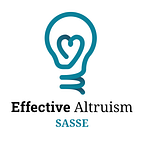An Introduction to Effective Altruism
[This is the 1st of a series of articles from the SASSE Sustainability Group from the Stockholm School of Economics concerning the global Effective Altruism movement]
Effective Altruism is the world-wide movement devoted to improving the world in the most logical, evidence-based way possible. It isn’t all about donations, it’s a worldview and a way of life that brings rationality to what people choose to care about and how they spend their time rather than using guesswork or gut instincts. In determining the promise of making real impact and the causes that should be prioritized, EA suggests considering ones with the following characteristics- great in scale, highly neglected, and highly solvable, meaning that the individual can have a great marginal impact. Effectiveness is stressed in all areas, it’s their obsession with converting every dollar into lives saved or “quality-adjusted years of life”. A lot of charities tend to give misleading figures but EA, stressing cost-effectiveness, thus conduct analyses of charities around the world to find the ratio between the cost and impact of an intervention, helping us be able to make the most significant difference.
These analyses embody the fundamental concept of evidence-based research which is ingrained into the EA movement. Donation recommendations shouldn’t be based on feelings, emotions, or marketing — instead, EA provides scientifically evident answers. When being asked about the most pressing problems, many people are likely to name those that they are frequently exposed to by public advertisements or fundraisers asking for donations on busy streets in big cities. In turn, these people are inclined to donate to these well-known charities because of their extensive marketing activities. While these activities help to spread awareness, charities pay money for them, hence lowering the cost-effectiveness of respective donations. It comes as no surprise that EA’s top picks for cost-effective charities are usually less-known (since they do less marketing) and have a narrow geographic scope (which enhances capital allocation, economies of scale, and local expertise).
One illustrative example that shows how EA assesses charities based on evidence deals with the cost-effectiveness of different malaria treatments: The WHO estimates that in 2015 alone, 438,000 people died of malaria. While there are dozens of different ways to combat malaria, including the malaria vaccine and efforts of eradicating the mosquito species responsible for spreading the disease, the distribution of bed-nets is revealed to be the most cost-effective way to go- contradictory to most people’s instincts. Similarly, in doing a cost-effectiveness analysis of intervention types of HIV, wide discrepancies between the types can be noted. Considering the 4 most common intervention types of HIV: surgical treatment, antiretroviral therapy, prevention of transmission from mother to child during pregnancy, condom distribution to prevent transmission, and education for high-risk groups. Interestingly, the results of the analysis show that purely educating high-risk groups can be 1,400 times as effective as performing surgical treatments for those with aids, contradictory to common guesswork.
“You’re gonna notice that you’re not noticing” — this is one of the key messages that many Effective Altruists use to encourage donations, particularly of privileged people in developed economies like all of us Handels students. Some passionate altruists even take this to the extreme of “pledging to give”, which means that they (non-binding) pledge to continuously give a certain % of their annual income to charitable causes. Nowadays, this is not only pursued by multi-billionaire philanthropists like Bill Gates, but also by average people like you and me on platforms such as givingwhatwecan.org. Usually, those pledges aim to account for 10% of one’s regular annual income, but any pledging amount is more than welcome. The platform also provides a calculator to show how well off we actually are and what impact even small donations can already have. Just by graduating from the Handels Bachelor program, we would start with an average annual gross salary of c. SEK464,000 (net after taxes c. SEK 240,000), which is equivalent to the richest 5.8% of the world population! Donating 10% of our net income would already be equivalent to saving 0.8 healthy lives and still put us in the richest 6.9%! We highly encourage you to keep this in mind once you graduate;)
Sources: Effective Altruism Sweden, Effective Altruism Australia, Washington Post, Forbes, Givingwhatwecan.org, SSE BSc Employment Report
